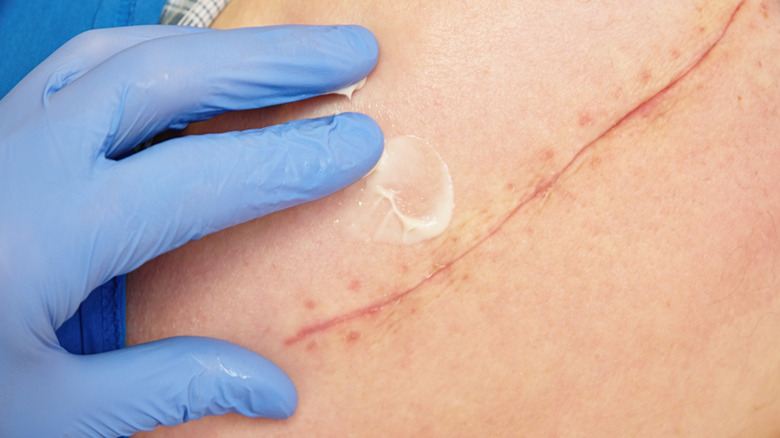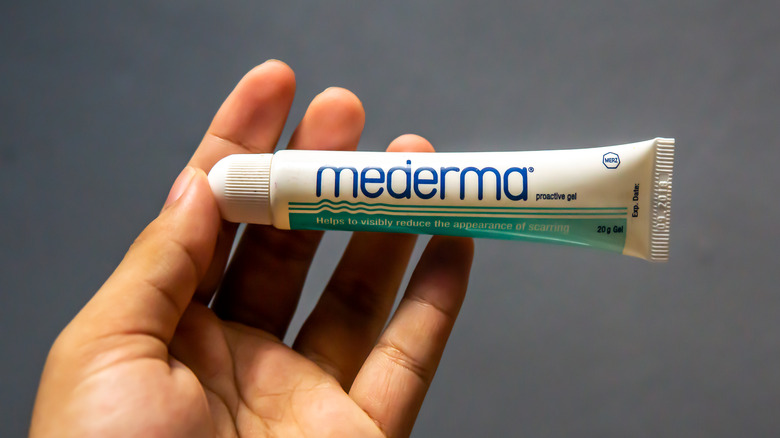Things That Really Work To Reduce The Appearance Of Scars
If you've lived on the planet long enough to be able to read this article, chances are you probably have a scar somewhere on your body. Scars are in many ways inevitable, and while they can be frustrating, unsightly, and, in some more extreme cases, even interfere with your daily life, there are effective options for helping to reduce their appearance.
According to John Hopkins Medicine, "a scar is the body's natural way of healing and replacing lost or damaged skin." The site explains that the form a scar takes can vary based on the nature of the injury — some can be flat, while others can be bumpy or discolored. Other factors that determine a scar's appearance can be age, the location of the injury, and the overall health of the person. While most scars fade with time, some can take longer than others to fade or disappear and can require intervention, especially if you are uncomfortable with their presence.
Treatments can vary from surgical intervention to over-the-counter medication and natural home remedies (via Healthline). Here's a look at some treatments that really do reduce the appearance of scars.
Silicone gel
Silicone gel is one of the most effective over-the-counter treatments to help reduce a variety of scar types, according to Healthline. The site explains that silicone can come in the form of sheets that can be cut and applied to specific areas, or applied topically to the affected area in gel form.
A study published by the Journal of Cutaneous and Aesthetic Surgery, which tested the effectiveness of a topical gel treatment, showed a considerable reduction of scars across the board after six months of continuous use. The study evaluated participants with a variety of scar types (superficial, hypertrophic, and keloid scars) as well as scars that were less than a month old to more than six months old, and found the gel to be effective for all of them.
The study authors explained that the silicone works by hydrating the skin, and helping it to regulate the production of fibroblast, which is a type of cell that is responsible for healing wounds. This helps regulate collagen production and can help soften and flatten the scar. For fresher scars, the gel also helps to form a protective barrier between the skin and the outside, preventing bacteria from entering and causing further injury and the potential for more scar tissue.
Scar massage
While this technique may appear to add insult to injury by working an already sore spot, scar massage is actually an effective form of physical therapy that can help heal scar tissue. According to Verywell Health, this type of treatment is primarily used for those who have experienced surgery, fractures, and muscle injuries and is not for minor cuts and scrapes.
Experts at the site explain that after an injury, the body creates excess collagen to help repair the wound, which is what creates scar tissue. Eventually, the scar tissue will "remodel" to return the body to its normal range of motion. However, if this step is missed, the tissue and surface area can become tight and limit mobility. Scar massage aims to help promote tissue remodeling and assist the overall healing process.
Therapists typically use some form of lubricant to keep the skin hydrated during this treatment, and will massage along the scar line to help realign the collagen fibers. Before you opt for scar massage, be sure to consult with your doctor and make sure your wound is healed enough before treatment. If not, massage can potentially reopen the wound, allowing bacteria to enter and worsening the healing process (via Verywell Health).
Laser therapy
Laser treatment is another viable option for those looking to reduce the appearance of a variety of scar types. According to Medical News Today, essentially lasering off the top layer of skin removes the damaged tissue and stimulates new cell growth in its place. The site explains that even though the laser is technically creating a scar, the new scar will heal more evenly than the old one.
Laser therapy is not just a good option for improving the aesthetic appearance of scars — it's also useful for scars that are painful, itchy, or ones that have reduced your range of motion. Doctors can use a number of different lasers for this therapy depending on the patient's needs, including lasers that treat the top layer of the skin, as well as those that target the layers underneath.
This treatment is not recommended for deeper scars, but is suitable for scars from acne, burns, surgery, or other minor injuries, according to Medical News Today. Before your treatment, you should avoid using medications that increase the risk of bleeding (e.g., aspirin) or products that contain retinoids. You should also refrain from any cosmetic procedures (e.g., chemical peels) before laser treatment.
Microneedling
It's understandable if seeing the word needle makes you wince, but this particular treatment is relatively painless, and is quite effective at reducing the appearance of scars (via Healthline).
Microneedling, also known as dermarolling or skin needling, is a procedure in which a skin care professional rolls a tool with small needles onto your skin, creating tiny holes in the top layer, which triggers the production of more collagen.
One study found that 120 patients who received six consecutive monthly microneedling treatments saw at least a 50% improvement in scar reduction after two weeks, with 65% of patients showing a 75% improvement. According to Healthline, microneedling is typically recommended for the treatment of recessed scars because the collagen produced will fill in the recessed space. However, if your scar is raised (meaning you have overproduced collagen), microneedling may actually worsen it.
Some side effects after treatment may include redness, swelling, and perhaps light bruising, but experts at Healthline explain that this should be cleared up a few days after treatment. You may need to go in for multiple treatments if your scars are "moderate," according to the Healthline, with a wait time of up to six weeks between each treatment.
Bio-Oil
This classic beauty product has been around for some time and has garnered a cult following for its proven ability to reduce the appearance of scars (via Healthline). According to Healthline, Bio-Oil was specifically developed to help prevent both scars and stretch marks, and includes a number of natural oils including sunflower, rosemary, and lavender, as well as Vitamin E. The product is intended to improve the appearance of both old and new scars and is most often used to treat a number of different acne scars. One study that evaluated 80 people with scars found that those who used Bio-Oil as a treatment saw a 14% reduction of their scars after eight weeks (via Healthline).
If you are sensitive to fragrance, the classic Bio-Oil contains linalool as well as other synthetic ingredients, which may cause an allergic reaction for some. However, as Allure reported in 2021, the company launched a natural version of the cult classic without the added fragrance. The new formula includes safflower oil, which is not in the old product and is known to help reduce the appearance of non-keloid scars.
Coconut oil
You've seen it used in everything from mouthwash to your morning coffee and now, as a scar reducer. The many uses of coconut oil are abundant, so its use to treat scars may not come as much of a surprise.
According to Healthline, many of the benefits associated with coconut oil have to do with its moisturizing properties and the way it acts as a barrier while skin is in the process of healing. The site also reports that coconut oil is known to help increase the production of collagen, which may aid in the process of scar healing. A 2010 study published by Skin Pharmacology and Physiology tested three groups of rats recovering from wounds and found that those who were treated with virgin coconut oil experienced quicker healing time and an increase in collagen production.
Furthermore, according to Healthline, coconut oil contains high amounts of vitamin E. Another study that tested patients after surgery found that vitamin E prevented the production of keloids post-surgery in all of them.
Aloe vera
Aloe vera is probably best known for its cooling and soothing sensation — particularly by those who've had the unfortunate experience of laying out in the sun for too long. Board-certified dermatologist Rachel Nazarian told Byrdie, "Aloe vera is a wonderful natural option for reducing the residual injury to skin caused by acne or other wounds. There are studies that have shown aloe vera to increase growth factors for fibroblasts — the cells that make collagen. It's possible that this is the pathway that allows aloe to improve wounds and scars, via the production of enhanced and increased collagen fibers." She continued, saying, "It's a great alternative medical treatment following burns or skin injury."
According to Byrdie, aloe vera is made up of mostly water, as well as amino acids, lipids, vitamins, enzymes, and polysaccharides. It also contains chemicals that contribute to the wound healing process and decrease inflammation. Aloe vera can be found in several forms; however, Nazarian recommends applying it in gel form over the affected area to get the best results.
Steroid injections
No longer just known for its questionable involvement in athletic performance, steroid injections may be an effective line of treatment in reducing the appearance of scars. According to John Hopkins Medicine, keloid scars are one of the scar types that benefits the most from steroids.
Keloid scars are "thick, rounded, irregular clusters of scar tissue" that form at the site of the wound as well as around it, according to the site. They are a result of excess collagen production and are typically darker in color than the normal skin tone. Steroids can be injected directly into the scar, which may help decrease the size as well as some of the discomfort they produce. The site explains that steroid injections may also be effective for hypertrophic scars, which are similar to keloid scars but are smaller in size. For these scar types, steroids can be injected into the scar or applied topically to reduce their appearance.
Cryosurgery
Using extremely cold temperatures to freeze your scars might seem a bit odd, but according to science, it's a promising treatment. Cryosurgery requires using extremely cold temperatures — typically via liquid nitrogen at temperatures of -346 and -320 degrees Fahrenheit — to freeze problematic tissue (via Healthline). The therapy is often used in cases of cancer, as the nitrogen is able to kill off cancer cells at such low temperatures.
In the case of healing scars, according to a study published by the Archives of Dermatology which tested 93 white patients with keloid and hypertrophic scars, at least 61% of the patients recorded "good" to "excellent" responses in their scar recovery after 32 months of follow up. In this procedure the scientists applied the liquid nitrogen directly to the affected area for 30 seconds per lesion, and repeated the procedure after 30 days, concluding that it was an effective and safe way to treat both scar types.
According to Healthline, some of the potential side effects of the treatment include additional scarring, blisters, and pain. Your doctor will ultimately decide whether or not you are a good candidate for the surgery.
Helichrysum, frankincense, and hyssop essential oils
Essential oils are definitely having a moment, and they have a number of different applications that range from soothing digestive issues to helping heal your scars.
According to Healthline, essential oils can help regenerate skin cells. They can also improve the overall appearance of your scars by balancing their tone, reducing redness at the site of the scar, and reducing inflammation. Some essential oils can even assist in healing fresher wounds, which can in turn improve their appearance as they heal.
Experts at the site recommend Helichrysum essential oil, in particular, for its anti-inflammatory and antioxidant properties, among others. The antioxidants in this oil help to regenerate new cells and limit the production of free radicals. It also helps stimulate collagen production. Another oil that is useful is frankincense, which is known to even out skin tone and may assist in the growth of new skin cells. Additionally, hyssop essential oil has "antiseptic, antifungal, and antibacterial properties," according to Healthline, and can be used in the wound healing process to help improve the appearance of scars down the line.
Rosehip oil
If you didn't know that rose plants produced fruit, you do now. Rosehip oil comes from the fruit — yes, the fruit — of the rose plant, and is used to treat a number of skin conditions as it acts as both an anti-inflammatory agent as well as an antioxidant (via WebMD). It contains high levels of vitamin C and certain fatty acids that are known to help treat wounds and scars by softening the skin and making it more porous.
Furthermore, a study involving 160 patients who just received surgery were divided into two groups — one that received rosehip oil as a treatment, and one that did not — and the group that was given the rosehip oil saw a reduction in the redness of their scars after six to 12 weeks. Experts at the site say that the oil can be applied directly to the affected area and to expect results after 12 weeks of regular use.
If you want a double boost of scar healing power, rosehip oil can be used as a carrier oil for other essential oils, according to Healthline, so you can mix it with other scar-healing oils to amplify its benefits. If you are looking to prevent acne breakouts, which can lead to scarring down the line, you can also take rosehip supplements to treat acne from the inside out thanks to their anti-inflammatory properties (via WebMD).
Mederma
Mederma is a cult classic that comes in the form of a gel and is specifically made to target scars. One study that trialed Mederma on 44 participants found that after it was applied to both new and old scars three times a day for eight weeks, a considerable improvement was seen in the appearance of the scars.
According to Healthline, one of the active ingredients in Mederma, which is onion bulb extract, works as an anti-inflammatory and antioxidant, and thus helps to improve the appearance of scars and the redness and inflammation associated with them.
According to Verywell Health, studies have shown that onion extract is also effective in improving collagen production. Mederma also contains the active ingredient allantoin, which "reduces itching, irritation, and dryness," according to Healthline. An additional component of Mederma is SPF, which helps protect scars against sun exposure, which is known to cause further damage (via Healthline). The treatment is meant to be used on wounds that have already closed and it needs to be applied three times a day in order to see the best results.
Vitamin C
No longer just a remedy to fight the common cold, vitamin C has made its way into skincare products and boasts a number of positive benefits. If you're not in on the vitamin C scoop, Healthline explains that the vitamin is "one of the best anti-aging ingredients on the market" and provides a "smooth, even, and glowy complexion." Not bad.
In terms of scars, some of the specific benefits the site lists are the reduction of redness, hyperpigmentation, boosting collagen production, and assisting in wound healing. Elaborating on these benefits, Dr. Joshua Zeichner, an assistant professor in the dermatology department at Mount Sinai Medical Center in New York City, told Allure, "Vitamin C is an antioxidant that we commonly recommend to treat dark spots and sun damage because of its ability to brighten the skin. Just as it can brighten sun spots on your face, it can do the same to pigmentation around scars. Unlike traditional scar gels that improve not only pigment, redness, and texture of the scar itself, vitamin C targets primarily pigment." As such, he recommends applying a scar gel first and then using vitamin C.
Green tea
Rounding out the list is perhaps a somewhat unexpected remedy with a number of applications. Many may already be familiar with the high level of antioxidants in green tea, so it might not come as a surprise that those same antioxidants can work magic on the skin.
According to Healthline, green tea works as both an anti-inflammatory and an antioxidant, which in addition to treating scars can also help manage acne and oily skin. It has been specifically studied for its benefits in healing keloid scars as well, according to the site. A study published by The International Journal of Surgery tested three groups of rats who had just been given surgery, and applied green tea extract to one of the groups. The group that was given the green tea extract saw a considerable improvement of healing compared to the rest, with the scientists concluding that "green tea extract could help wound healing process" and was "probably effective on surgical wounds healing."
To get the most direct benefits of green tea for treating scars you can take green tea extract (which is a higher concentration of green tea) in pill form or find skincare products that contain the ingredient (via Healthline).















